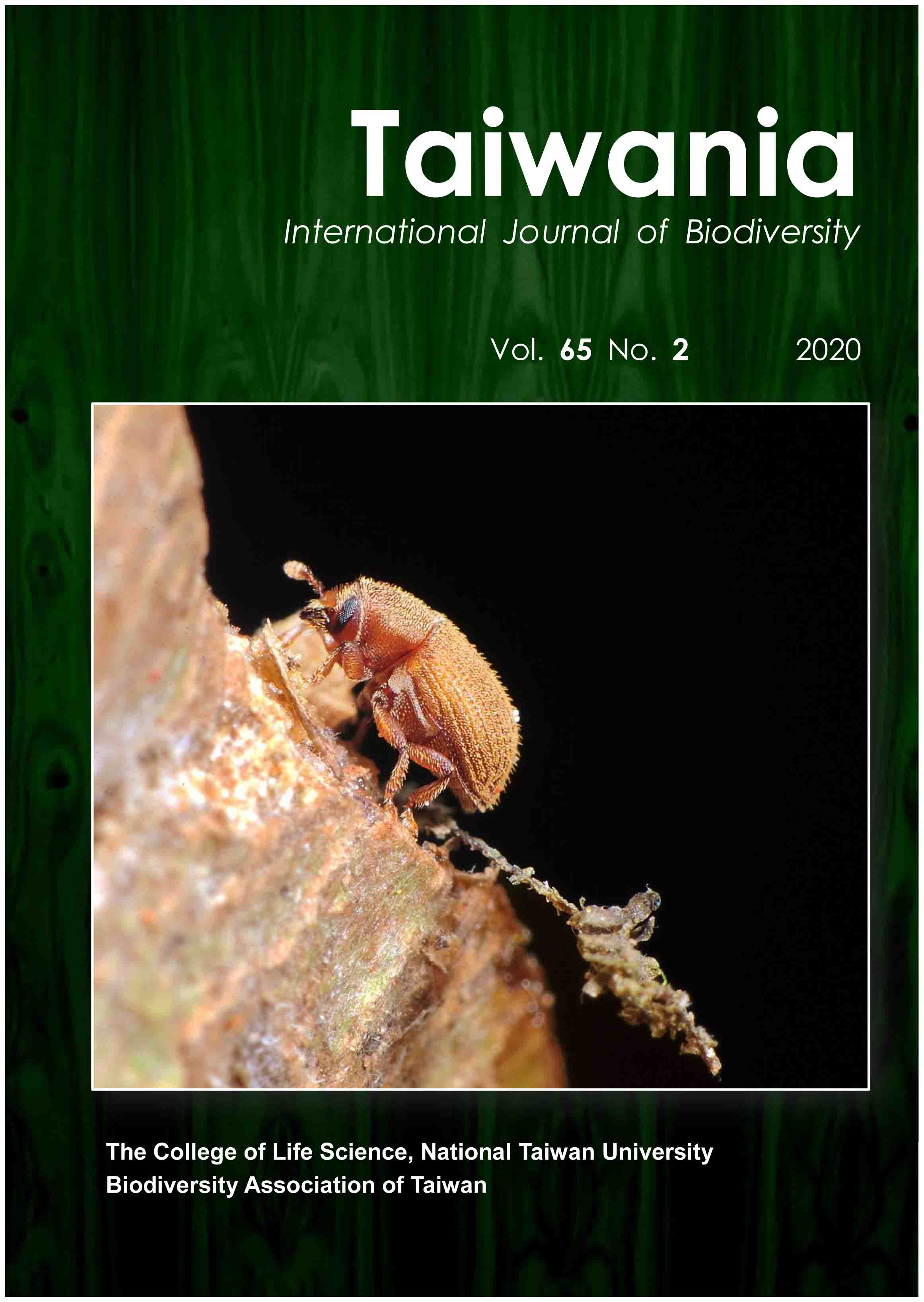Note
Development and characterization of EST-SSR markers in creeping mazus (Mazus miquelii), and cross-amplification in five related species
Masaya Yamamoto, Daiki Takahashi, Chih-Chieh Yu, Hiroaki Setoguchi
Published on: 18 April 2020
Page: 249 - 252
DOI: 10.6165/tai.2020.65.249
Abstract
Simple sequence repeat (SSR) markers were developed from expressed sequence tags (ESTs) for Mazus miquelii (Mazaceae), one of the most widespread species of the genus found in mainland China to Japan and North America, with the goal of elucidating the hidden genetic diversity and pollination ecology of the species. Of the initial 48 EST-SSR markers designed based on transcriptome data, 36 loci were successfully amplified, 16 of which were polymorphic. Polymorphisms for these markers were tested on 72 individuals from three populations in Japan. Two to eleven alleles per locus were detected, and the levels of observed and expected heterozygosity ranged from 0.181 to 0.708 and 0.154 to 0.715, respectively. Most loci were amplified successfully in five related Japanese and Taiwanese species. These markers will empower ecological and evolutionary studies in the creeping mazus and facilitate the disentanglement of phylogenetic relationships with related species.
Keyword: microsatellite, genetic diversity, expressed sequence tag, Mazus, Mazaceae
Literature Cited
Bolger, A.M., M. Lohse and B. Usadel. 2014. Trimmomatic: A flexible trimmer for Illumina sequence data. Bioinform. 30(15): 2114–2120.
DOI: 10.1093/bioinformatics/btu170View Article
Google Scholar
Bouck, A. and T. Vision. 2007. The molecular ecologist's guide to expressed sequence tags. Mol. Ecol. 16(5): 907–924.
DOI: 10.1111/j.1365-294X.2006.03195.xView Article
Google Scholar
Deng, T., N. Lin, X. Huang, H. Wang, C. Kim, D. Zhang, W. Zhu, Z. Yusupov, K.S. Tojibaev and H. Sun. 2019. Phylogenetic of Mazaceae (Lamiles), with special reference to intrageneric relationships within Mazus. Taxon 68(5): 1037–1047.
Doyle, J. and J.L. Doyle. 1987. Genomic plant DNA preparation from fresh tissue?CTAB method. Phytochem. Bull. 19: 11–15.
Du, L., C. Zhang, Q. Liu, X. Zhang and B. Yue. 2017. Krait: an ultrafast tool for genome-wide survey of microsatellites and primer design. Bioinform. 34(4): 681–683.
DOI: 10.1093/bioinformatics/btx665View Article
Google Scholar
Ellis, J.R. and J.M. Burke. 2007. EST?SSRs as a resource for population genetic analyses. Heredity 99(2): 125–132.
DOI: 10.1038/sj.hdy.6801001View Article
Google Scholar
Gupta, P.K., S. Rustgi, S. Sharma, R. Singh, N. Kumar and H.S. Balyan. 2003. Transferable EST-SSR markers for the study of polymorphism and genetic diversity in bread wheat. Mol. Genet. Genomics. 270(4): 315–323.
DOI: 10.1007/s00438-003-0921-4View Article
Google Scholar
Haas, B.J., A. Papanicolaou and M. Yassour, M. Grabherr, P.D. Blood, J. Bowden, M.B. Couger, D. Eccles, B. Li, M. Lieber, M.D. MacManes, M. Ott, J. Orvis, N. Pochet, F. Strozzi, N. Weeks, R. Westerman, T. William, C.N. Dewey, R. Henschel, R.D. LeDuc, N. Friedman, A. Regev. 2013. De novo transcript sequence reconstruction from RNA?seq using the Trinity platform for reference generation and analysis. Nat. Protoc. 8(8): 1494–1512.
DOI: 10.1038/nprot.2013.084View Article
Google Scholar
Hong, D.Y., H. Yang, C.L. Jin and N.H. Holmgren. 1998. Scrophulariaceae. In: Wu, Z.Y. and P.H. Raven (eds.), Flora of China, vol. 18: 1–212. Science Press, Beiling.
Hsieh, T.H. 2000. Revision of Mazus Lour. (Scrophulariaceae) in Taiwan. Taiwania 45(2): 131–146.
DOI: 10.6165/tai.2000.45(2).131View Article
Google Scholar
Jin, X.F., Z.M. Ye, Q.F. Wang and C.F. Yang. 2015. Relationship of stigma behaviors and breeding system in three Mazus (Phrymaceae) species with bilobed stigma. J. Syst. Evol. 53(3): 259–265.
DOI: 10.1111/jse.12137View Article
Google Scholar
Jin, X.F., Z.M. Ye, G.M. Amboka, Q.F. Wang and C.F. Yang. 2017. Stigma Sensitivity and the Duration of Temporary Closure Are Affected by Pollinator Identity in Mazus miquelii (Phrymaceae), a Species with Bilobed Stigma. Front. Plant Sci. 8: 783.
DOI: 10.3389/fpls.2017.00783View Article
Google Scholar
Kimata, M. 1978. Comparative studies on reproductive systems of Mazus japonicus and M. miquelii (Scrophulariaceae). Plant Syst. Evol. 129(4): 243–253.
DOI: 10.1007/BF00982750View Article
Google Scholar
Meirmans, P.G. and P.H. van Tienderen. 2004. GENOTYPE and GENODIVE: two programs for the analysis of genetic diversity of asexual organisms. Mol. Ecol. Notes 4(4): 792–794.
DOI: 10.1111/j.1471-8286.2004.00770.xView Article
Google Scholar
Newcombe, F.C. 1924. Significance of the behavior of sensitive stigmas II. Am. J. Bot. 11(2): 85–93.
DOI: 10.1002/j.1537-2197.1924.tb05763.xView Article
Google Scholar
Raymond, M. and F. Rousset. 1995. GENEPOP (Version1.2): population genetics software for exact tests and ecumenicism. Heredity 86(3): 248–249.
DOI: 10.1093/oxfordjournals.jhered.a111573View Article
Google Scholar
Untergasser, A., I. Cutcutache, T. Koressaar, J. Ye, B.C. Faircloth, M. Remm and S.G. Rozen. 2012. Primer3 - new capabilities and interfaces. Nucleic. Acids Res. 40: e115.
DOI: 10.1093/nar/gks596View Article
Google Scholar
van Oosterhout, C., W.F. Hutchinson, D.P. Wills and P. Shipley. 2004. MICRO?CHECKER: software for identifying and correcting genotyping errors in microsatellite data. Mol. Ecol. Notes 4(3): 535–538.
DOI: 10.1111/j.1471-8286.2004.00684.xView Article
Google Scholar


